Modes of exposure:
- Direct strike to equipment (Q)
- Direct strike to building containing the equipment
- Direct strike to building containing interconnected equipment
- Voltage induced in connecting cables
- Voltage induced in ground loop
- Voltage induced in antenna
- Parallel paths damage components
- Voltage induced in sensor or cable
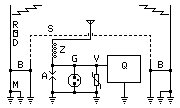
- Lightning rods (ROD - better path to ground)
- Multiple grounds (M)
- Bonding (B)
- Lightning shield (S - a Faraday cage)
- Impedance trap (Z)
- Lightning arrestor air spark gap (A)
- Varistors (V)
- Gas discharge tubes (G)
- Parallel path protection
- Prevent triggering ground fault circuit interrupters
- Removing ground loop problems
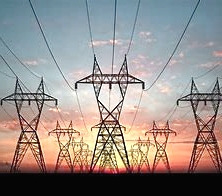
The lightning rod attracts lightning away from equipment by providing
an easier path to ground.
- The ionization process before a stroke usually chooses the
best path.
- Other ionized paths are incomplete, so no lightning follows them.
Lightning rods are used to protect buildings.
A tall radio tower with a grounded structure acts as a huge lightning rod.
- The protection from the tower on flat terrain is usually to a radius of about
10 times the tower height.
High voltage power lines (right) have three wires under the top crossbar that carry
the three power phases.
- Notice the insulators that separate the power-carrying wires from the tower
and identify them.
- The two wires at the tops are grounded to each tower and act as continuous
lightning rods.
- Those wires are collectors attracting lightning strokes away from the power
lines.
- This is an example of both lightning rod and multiple grounds (at each
tower).
Bonding metal parts of the building together electrically reduces lightning
voltages between them.
- This keeps all of the parts of the building at nearly the same voltage.
- This prevents electrical shock when someone touches two parts of the
building during the stroke.
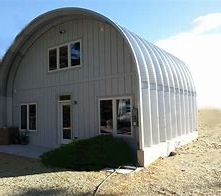
An all-metal building exterior provides a Faraday cage. This blocks all electrical fields.
- If the exterior of the building is steel, it also blocks all magnetic fields.
- Metal buildings also block radio waves.
- Make sure the metal shell of the building is grounded with multiple grounds.
- Large areas with nonmetallic walls (e.g. windows) do not block these completely.
- A direct lightning stroke on the building probably will not harm it.
- Large buildings with metal framework provide more protection if the frame is grounded at multiple points.
Metal enclosures for devices such as phone junction boxes and traffic signal controls also do this.
- For more protection, combine diversion (lightning rod or collector) with a grounded enclosure.
- Shielded cables work for short distances. For longer distances, extra grounds and shields are needed.

An impedance trap uses coils and capacitors to divert the strike.
- Lightning strokes and surges have very large high frequency components.
- Capacitors pass high frequencies and block low frequencies.
- Capacitors shunt the highest surge frequencies to ground.
- Inductors (coils) pass low frequencies and block high frequencies.
- Coils block the highest surge frequencies.
- Part values must be chosen to reject surges while not blocking useful frequencies.
- This can be combined with other methods.
- A long wire has the properties of a series inductor.
- A long unshielded wire also has the properties of an antenna.
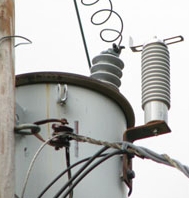
A spark gap can bypass extremely high voltages to ground, protecting equipment.
- The gap (right, upper right corner) is the gap between the fixed high voltage electrode and the adjustable slide.
- Air gaps such as this one are unreliable because rain can reduce the protection voltage.
- Larger air gaps are used to protect radio and television transmitter aerials.
- Smaller air gaps are used to protect home aerials.
- New ones are enclosed in a plastic or Bakelite box to protect them from weather.
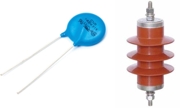
A varistor changes its conductivity from almost zero to nearly a short circuit with high enough voltage.
- The varistor on the left of the image is a small one (~ 1 inch) designed for use on a printed circuit board.
- The varistor on the right of the image is a big one (~ 8 inches) designed for
use on power lines.
- The insulated tube is filled with many grains of sintered metallic
oxides.
- A varistor shorts the high voltage surge to ground.
- Varistors work equally well with AC or with DC of any polarity.
- Metallic Oxide Varistors (MOVs) are the most common types of varistor. Zinc Oxide is most commonly used.
- The surge protectors in portable power strips are MOVs.
- If the power of the strike or surge is too great, the varistor can fail, short, shatter, or explode.
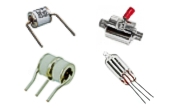
A gas discharge tube changes conductivity from zero to a short circuit with high enough voltage.
- The gas tube at top the left of the image is designed for use on a printed circuit board.
- The gas tube at top right is designed to be used with coaxial cable. The red
terminal goes to ground.
- These are made with various connectors for different kinds of coax.
- The gas tube at bottom left is a 3-terminal version of the one above, with a common gas cell. See below.
- The gas tube at bottom right is a 3-terminal neon tube for protecting small signal lines. See uses below.
- A gas tube shorts the high voltage surge to ground.
- Gas tubes work equally well with AC or with DC of any polarity.
- Various noble gases, including neon, argon, krypton, and xenon are used in these.
- If a strike/surge has too much power, the gas tube can explode. So most have metal or ceramic cases.

Parallel signal paths (twisted pairs or shielded cables) need special protection.
In many cases, protecting cables with two conductors with a gas tube on each wire did not work.
- Even though two gas tubes or MOVs were used, the equipment (Q) was still damaged.
- A surge on one conductor often leads a surge on the other by a few microseconds.
- When two tubes are used (top), the first surge fires the tube and is shunted to ground.
- But the second surge finds it easier to go through the equipment to get to the
already fired tube.
- This damages the equipment (Q).
- When a 3-electrode tube is used (bottom), the first surge fires the tube and is shunted to ground.
- The second surge finds the tube already ionized, so it also goes through the
tube to ground.
- This protects the equipment (Q).
This works with twisted pairs, coaxial cables, balanced line cables, and 3-wire power cables.
Devices sold to protect homes from lightning strikes are large 3-electrode tubes
connected to the
service entrance wires. These fit into electric meter sockets.

Voltages on one building can follow a cable to another building.
Note that the earth grounds of most buildings have electrical resistance in them
The National Electrical Code requires the resistance must be no more than 25 Ohms.
When lightning strikes a building, most of the voltage is across this resistance.
- This raises the voltage of the building and everything in it above ground
- This voltage can be as high as 750000 volts.
- Since building contents are at the same voltage, nothing inside the building is harmed.
The damage occurs when a cable runs between buildings.
- Now the voltage on the building follows the cable to a piece of equipment in the other building.
- The voltage destroys components in the equipment in the other building.
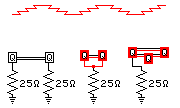
Lightning strokes can electromagnetically introduce large currents in ground loops.
- A ground loop is one or more low resistance circular paths between devices.
- This complete circle lets a magnetic field induce a high current.
- Ground loops are notorious for picking up electronic noise and adding it to small signals.
- Likewise, a ground loop can introduce high voltage variations in signal and power lines.
- The ground loops with the induced high current are shown in red.
- Resistances in the earth grounds are usually high enough to prevent high ground loop current.
- A ground loop can be broken by removing a ground connection between devices.
- Inserting a small resistance into the ground loop also removes the ground loop.
- Do not remove the safety ground pin on a power cord to break a ground loop.
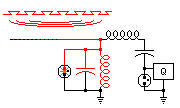
Lightning strokes can electromagnetically induce large voltages in antennas.
- A wire (antenna) running parallel to a lightning stroke can have a voltage induced on it.
- The page author once got shocked on a metal umbrella shaft.
The shaft happened to be held parallel to a stroke in a storm 10 miles away.
- This can damage radio equipment connected to the antenna.
- Damage can be prevented using impedance, tuned circuits, varistors, and gas discharge.
- Tuned circuits (coil-capacitor combinations - shown) can control where signals go.
They can direct the wanted signal to the equipment
while directing other frequencies to ground.
- Capacitor and coil in series pass only the wanted frequencies.
- Capacitor and coil in parallel pass all except the wanted frequencies.
- These parts must be able to stand the induced voltages.
- If a transmitter is connected to the antenna, the protection devices must withstand
the output signal, but not shunt it to ground.

- Use surge-protection power strips to protect your sensitive equipment.
The best strips have all of the following devices (shown):
- Three Metallic Oxide varistors (MOVs) are connected in a delta circuit.
They are connected hot-to-neutral, hot-to-ground, and neutral-to-ground. - A 3-electrode gas tube connected, to hot, neutral, and ground.
- A capacitor connected hot-to-neutral
Do not connect capacitors hot-to-ground or neutral-to-ground.
They will trip GFCI breakers. - A circuit breaker in case the surge shorts one of the protection devices.
- Three Metallic Oxide varistors (MOVs) are connected in a delta circuit.
- Put a lightning-diverting surge protector on the electric meter.
- Make sure the building ground is better than just adequate.
- Bond all substantial metal parts of the building to the building ground.
This includes all utility pipes and all metal structure members.
- Specially protect all signal cables coming into the building.
- Specially protect all antennas in or on the building.